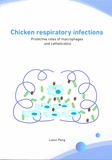Chicken respiratory infections
Protective roles of macrophages and cathelicidins

Peng, Lianci
- Promoter:
- Prof.dr H.P. (Henk) Haagsman
- Co-promoter:
- Dr E.J.A. (Edwin) Veldhuizen
- Research group:
- Haagsman
- Date:
- July 7, 2020
- Time:
- 10:30 h
Summary
Avian pathogenic E. coli (APEC) is one of most prevalent pathogens causing systemic diseases called avian colibacillosis. During APEC infection, epithelial cells in the lung are the first cellular defense line against APEC infection and will produce cytokines and chemokines to initiate the immune response. Similarly, macrophages and heterophils will be quickly recruited to the site of infection to fight against the infection in the respiratory tract. Nevertheless, the exact role of these cells in controlling APEC infection is still unclear and therefore investigated in the studies described in this thesis. So far, the treatment of an APEC infection in chicken mainly depends on antibiotics, but increasing antibiotic resistance makes this less effective. Therefore, new anti-infectives are needed and host defense peptides (HDPs) such as cathelicidins are considered as a promising alternatives. In this thesis, we investigated the interaction of chicken macrophages and epithelial cells with avian pathogenic E.coli to establish an appropriate APEC infection model in vitro. Then, we investigated the immunomodulatory effect of CATH-B1 on the chicken macrophages. Furthermore, antiviral activity of chicken cathelicidins against influenza A virus was studied. In chapter 2, the interactions of chicken lung epithelial cells with APEC is described to understand the role of epithelial cells in APEC infections. The results showed APEC was able to adhere and subsequently invade cells from the chicken lung epithelial CLEC213 cell line exhibiting pneumocyte type II-like characteristics. Moreover, APEC infection resulted in a significant increase in IL-8 gene expression. In chapter 3, the interactions of macrophage HD11 cells with APEC is described to understand the role of macrophages in controlling APEC. The results showed APEC was phagocytosed and subsequenlt killed by HD11 cells, finally resulting in activation of HD11 cells by the release of NO and cytokines expression. In chapter 4, the establishment of a standardized culturing method of monocyte-derived macrophages is described. A 3-day culture was optimal to obtain pro-inflammatory M1-like macrophages. These cells were a homogenous population of flat, ‘fried-egg’ like shaped cells, similar to human M1 macrophages. Furthermore, LPS stimulation of the cultured cells induced gene expression of the pro-inflammatory cytokines IL-1β, IL-6 and IL-8 after 3 days of culture. Finally, it was shown that 3-day-cultured macrophages were able to phagocytose avian pathogenic E. coli (APEC) and respond by nitric oxide production. In chapter 5, the immunomodulatory functions of CATH-B1 are described increasing our understanding of the function of this cathelicidin. CATH-B1 showed anti-inflammatory effect on APEC-infected or LPS-stimulated macrophages. In chapter 6, the anti-IAV activity of CATH-B1 is described exploring the possible use of cathelicidins in the development of anti-infective therapies. CATH-B1 has good antiviral activity against IAV by binding to the viral particle and thereby blocking viral entry.